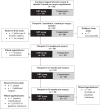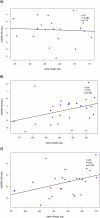Metabolic adaptation following gastric bypass surgery: results from a 2-year observational study
- PMID: 39227457
- PMCID: PMC11502489
- DOI: 10.1038/s41366-024-01585-5
Metabolic adaptation following gastric bypass surgery: results from a 2-year observational study
Abstract
Background/objectives: Metabolic adaptation is the lowering of basal metabolic rate (BMR) beyond what is predicted from changes in fat mass (FM) and fat-free mass (FFM) and may hamper weight-loss progression. It is unclear whether metabolic adaptation occurs following gastric bypass surgery (GBP) and if it persists. The aim of this study was to evaluate the reduction in BMR that is not explained by changes in body composition in patients following GBP compared to a weight-stable comparator group.
Subjects: Thirty-one patients [77.4% female; mean BMI 45.5(SD 7.0) kg/m2; age 47.4(11.6)y] who underwent GBP, and 32 time-matched comparators [50% female; BMI 27.2(4.6) kg/m2; age 41.8(13.6)y) were evaluated at 1-month pre-surgery, 3-, 12- and 24-months post-surgery.
Methods: BMR was measured under standardised residential conditions using indirect calorimetry and body composition using DXA. Linear regression analyses assessed metabolic adaptation post-surgery.
Results: After surgery, patients lost a quarter of their body weight [-25.6%(1.8%); p < 0.0001] consisting mainly of FM (4:1 FM to FFM loss ratio) at 24-months post-surgery. Absolute BMR (MJ/d) reduced by 25.7% at 24-months post-surgery with values becoming similar to the comparator group from 3-months post-surgery. Positive associations were observed between changes in BMR and changes in FFM and FM (P < 0.03). Metabolic adaptation was present in patients during the 1) rapid weight loss phase (6.9 kg/month at 3-months post-surgery) (p = 0.011), 2) slower weight loss phase (1.6 kg/month from 3 to 12-months post-surgery) (p < 0.0001), and, 3) weight maintenance phase (24-months post-surgery) (p = 0.00073). However, the degree of metabolic adaptation observed in GBP patients was similar to the weight-stable comparator group (no metabolic adaptation) from 12-months post-surgery onwards (3-months; p = 0.01, 12-months; p = 0.26, 24-months post-surgery; p = 0.70).
Conclusion: These results suggest that there is a potential biological mechanism of surgery that attenuates the expected postoperative downregulation in BMR thus helping GBP patients maintain weight loss.
© 2024. The Author(s).
Conflict of interest statement
CLW reports grants from the Irish Research Council, Science Foundation Ireland, Anabio, and the Health Research Board. He serves on advisory boards and speakers panels of Novo Nordisk, Herbalife, GI Dynamics, Eli Lilly, Johnson & Johnson, Glia, Irish Life Health, and Boehringer Ingelheim, Currax, Zealand Pharma, and Rhythm Pharma. ClR is a member of the Irish Society for Nutrition and Metabolism outside the area of work commented on here. He was the chief medical officer and director of the Medical Device Division of Keyron in 2021. Both of these are unremunerated positions. ClR was a previous investor in Keyron, which develops endoscopically implantable medical devices intended to mimic the surgical procedures of sleeve gastrectomy and gastric bypass. No patients have been included in any of Keyron’s studies and they are not listed on the stock market. ClR was gifted stock holdings in September 2021 and divested all stock holdings in Keyron in September, 2021. He continues to provide scientific advice to Keyron for no remuneration. ClR provides obesity clinical care in the Beyond BMI clinic and is a shareholder in the clinic. ADM reports research funding from Novo Nordisk, Fractyl and Randox.
Figures




References
-
- Versteegden DPA, van himbeeck MJJ, Nienhuijs SW. Improvement in quality of life after bariatric surgery: sleeve versus bypass. Surg Obes Rel Dis. 2018;14:170–4. - PubMed
-
- Ruiz-Lozano T, Vidal J, de Hollanda A, Scheer FAJL, Garaulet M, Izquierdo-Pulido M. Timing of food intake is associated with weight loss evolution in severe obese patients after bariatric surgery. Clinical Nutrition. 2016;35:1308–14. - PubMed
Publication types
MeSH terms
Grants and funding
LinkOut - more resources
Full Text Sources
Medical
Research Materials

